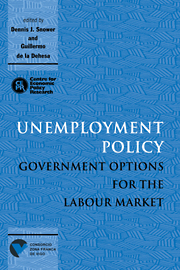Book contents
- Frontmatter
- Contents
- List of figures
- List of tables
- Preface
- Acknowledgements
- List of conference participants
- 1 Introduction
- PART ONE GENERAL POLICY ISSUES
- PART TWO DEMAND MANAGEMENT AND SUPPLY-SIDE POLICY
- PART THREE SUBSIDISING EMPLOYMENT AND TRAINING
- PART FOUR LABOUR MARKET REGULATIONS
- 12 An analysis of firing costs and their implications for unemployment policy
- Discussion
- Discussion
- 13 Labour market regulation and unemployment
- Discussion
- PART FIVE POLICY, JOB REALLOCATION AND THE UNEMPLOYMENT–PRODUCTIVITY RELATION
- PART SIX COMPARING UNEMPLOYMENT POLICIES
- Index
13 - Labour market regulation and unemployment
Published online by Cambridge University Press: 07 September 2010
- Frontmatter
- Contents
- List of figures
- List of tables
- Preface
- Acknowledgements
- List of conference participants
- 1 Introduction
- PART ONE GENERAL POLICY ISSUES
- PART TWO DEMAND MANAGEMENT AND SUPPLY-SIDE POLICY
- PART THREE SUBSIDISING EMPLOYMENT AND TRAINING
- PART FOUR LABOUR MARKET REGULATIONS
- 12 An analysis of firing costs and their implications for unemployment policy
- Discussion
- Discussion
- 13 Labour market regulation and unemployment
- Discussion
- PART FIVE POLICY, JOB REALLOCATION AND THE UNEMPLOYMENT–PRODUCTIVITY RELATION
- PART SIX COMPARING UNEMPLOYMENT POLICIES
- Index
Summary
Introduction
There is understandable concern about the stubbornly high level of unemployment in OECD countries, and a strong desire to find policies that can reduce it. It is no longer fashionable to blame a shortfall in aggregate demand for this situation, as such an explanation is generally thought to be unable to address the progressive rise in unemployment over the last 25 years. Among economists, the most common current view has been to identify the problem as being on the supply side of the economy and in the labour market in particular. ‘Interference’ in the free workings of the labour market which keep real wage costs above market-clearing levels is seen as one of the main causes of unemployment. The proposed cure for unemployment generally involves removal of these interferences or what we will call labour market de-regulation.
In this chapter we argue that this faith in the merits of labour market de-regulation is misplaced. We argue that economists have seriously over-emphasised the gains in terms of unemployment or more general measures of labour market efficiency to be obtained from de-regulation, and under-estimated the costs. If one asks someone who believes in the ability of labour market de-regulation to reduce unemployment about the source of their beliefs, they would probably cite various pieces of empirical evidence in support of their view. We consider this empirical evidence below and argue that it is much less persuasive than is commonly believed.
- Type
- Chapter
- Information
- Unemployment PolicyGovernment Options for the Labour Market, pp. 395 - 424Publisher: Cambridge University PressPrint publication year: 1997
- 23
- Cited by



